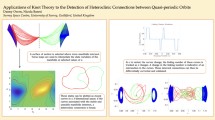Abstract
Motivated by the dynamics of resonance capture, we study numerically the coorbital resonance for inclination \(0\le I\le 180^\circ \) in the circular restricted three-body problem. We examine the similarities and differences between planar and three dimensional coorbital resonance capture and seek their origin in the stability of coorbital motion at arbitrary inclination. After we present stability maps of the planar prograde and retrograde coorbital resonances, we characterize the new coorbital modes in three dimensions. We see that retrograde mode I (R1) and mode II (R2) persist as we change the relative inclination, while retrograde mode III (R3) seems to exist only in the planar problem. A new coorbital mode (R4) appears in 3D which is a retrograde analogue to an horseshoe-orbit. The Kozai–Lidov resonance is active for retrograde orbits as well as prograde orbits and plays a key role in coorbital resonance capture. Stable coorbital modes exist at all inclinations, including retrograde and polar obits. This result confirms the robustness the coorbital resonance at large inclination and encourages the search for retrograde coorbital companions of the solar system’s planets.










Similar content being viewed by others
Notes
We use standard Keplerian elements for the test particle’s orbit: a (semi-major axis), e (eccentricity), I (inclination), f (true anomaly), \(\omega \) (argument of pericentre), \(\Omega \) (longitude of pericentre), M (mean anomaly), \(\lambda \) (mean longitude). The planet’s circular orbit has semi-major axis \(a_\mathrm{J}=1\) and mean longitude \(\lambda _\mathrm{J}\).
This is equivalent to obtaining a retrograde configuration of mutual inclination \(I>90^\circ \) from a prograde configuration of mutual inclination \(I<90^\circ \) by inverting the motion of the planet with respect to the star.
The chaotic region due to the cumulative effect of disruptive close encounters with the planet.
Also known as quasi-satellite orbits (Mikkola et al. 2004). These have clockwise motion around the planet in the synodic frame and are not true satellites since the orbits are bound to the star.
If all bodies are treated as point-like objects and evolution is allowed to continue, no collision occurs. Instead orbital reversal takes place (Yu and Tremaine 2001).
The 1:1 resonance Hamiltonian is invariant with respect to the transformation \((\phi ,-\omega )\rightarrow (-\phi ,\omega )\). The CR3BP is invariant with respect to the transformation \(\omega \rightarrow \omega +180^{\circ }\) and with respect to changes in \(\Omega \).
References
Cincotta, P.M., Simó, C.: Simple tools to study global dynamics in non-axisymmetric galactic potentials—I. A&AS 147, 205–228 (2000). doi:10.1051/aas:2000108
Goździewski, K.: Stability of the HD 12661 planetary system. Astron. Astrophys. 398, 1151–1161 (2003). doi:10.1051/0004-6361:20021713
Mikkola, S., Brasser, R., Wiegert, P., Innanen, K.: Asteroid 2002 VE68, a quasi-satellite of Venus. Mon. Not. R. Astron. Soc. 351, L63–L65 (2004). doi:10.1111/j.1365-2966.2004.07994.x
Morais, M.H.M., Giuppone, C.A.: Stability of prograde and retrograde planets in circular binary systems. Mon. Not. R. Astron. Soc. 424, 52–64 (2012). doi:10.1111/j.1365-2966.2012.21151.x. arXiv:1204.4718
Morais, M.H.M., Namouni, F.: Asteroids in retrograde resonance with Jupiter and Saturn. Mon. Not. R. Astron. Soc. 436, L30–L34 (2013a). doi:10.1093/mnrasl/slt106. arXiv:1308.0216
Morais, M.H.M., Namouni, F.: Retrograde resonance in the planar three-body problem. Celest. Mech. Dyn. Astron. 117, 405–421 (2013b). doi:10.1007/s10569-013-9519-2. arXiv:1305.0016
Murray, C.D., Dermott, S.F.: Solar System Dynamics. Cambridge University Press, Cambridge (1999)
Namouni, F.: Secular interactions of coorbiting objects. Icarus 137, 293–314 (1999). doi:10.1006/icar.1998.6032
Namouni, F., Morais, M.H.M.: Resonance capture at arbitrary inclination. Mon. Not. R. Astron. Soc. 446, 1998–2009 (2015). doi:10.1093/mnras/stu2199. arXiv:1410.5383
Namouni, F., Christou, A.A., Murray, C.D.: Coorbital dynamics at large eccentricity and inclination. Phys. Rev. Lett. 83, 2506–2509 (1999). doi:10.1103/PhysRevLett.83.2506
Nesvorný, D., Thomas, F., Ferraz-Mello, S., Morbidelli, A.: A perturbative treatment of the co-orbital motion. Celest. Mech. Dyn. Astron. 82, 323–361 (2002). doi:10.1023/A:1015219113959
Yu, Q., Tremaine, S.: Resonant Capture by Inward-migrating Planets. Astron. J. 121, 1736–1740 (2001). doi:10.1086/319401. arXiv:astro-ph/0009255
Acknowledgments
We thank Nelson Callegari Jr. for assistance with computational resources.
Author information
Authors and Affiliations
Corresponding author
Rights and permissions
About this article
Cite this article
Morais, M.H.M., Namouni, F. A numerical investigation of coorbital stability and libration in three dimensions. Celest Mech Dyn Astr 125, 91–106 (2016). https://doi.org/10.1007/s10569-016-9674-3
Received:
Revised:
Accepted:
Published:
Issue Date:
DOI: https://doi.org/10.1007/s10569-016-9674-3




